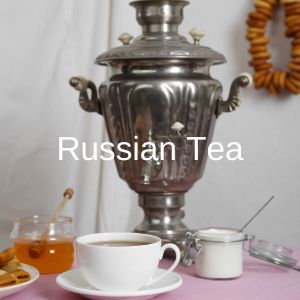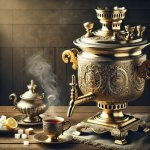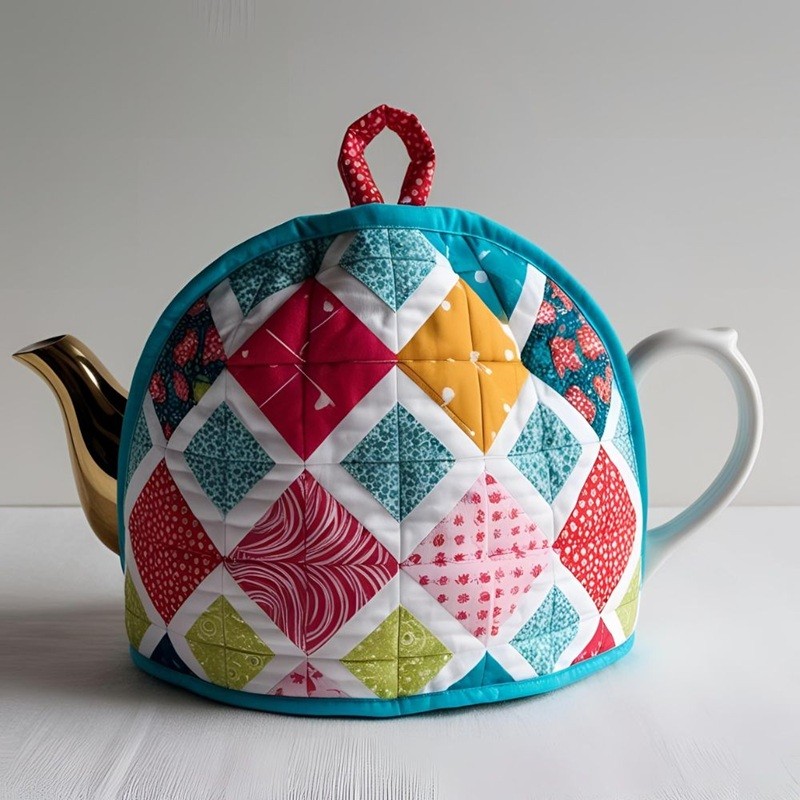The Samovar
-
Your Source of Hot Water
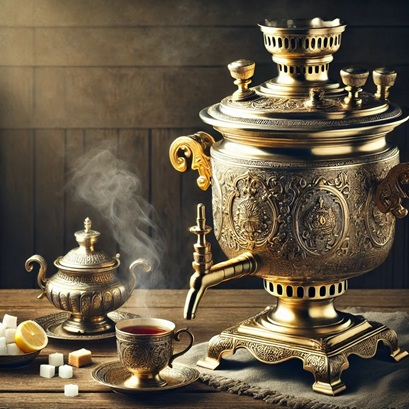
Typical of Russia, this heating vessel can also be found in many other countries where black tea was a favored drink of travelers along the old trade routes.
Is there still a place for this elaborate kettle in modern tea brewing?
Yes. Travel to Turkey, Iran or Russia and you find that traditional brewing techniques have not been forgotten and modern technology has helped to guarantee that the beloved samovar remains a part of the tea culture in many places.
What is the Samovar?
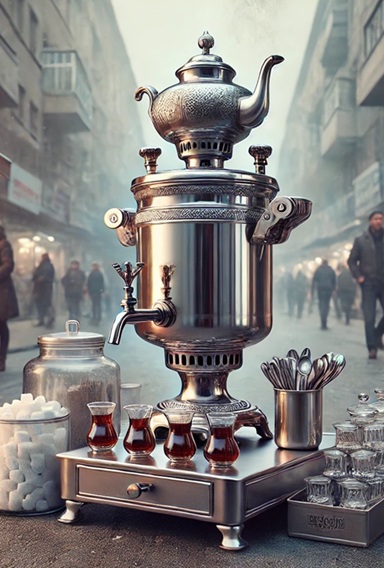
The Shape of the Samovar
This heating vessel has a particular shape of an urn with a chimney, and a spigot at its base from where the hot water may be poured to dilute concentrated tea. This is why many are also made to hold and heat a teapot with the tea on top of the urn.
The urn can be made from a variety of different metals such as stainless steel, copper, polished brass, tin, even silver or gold and they come in many sizes, holding anywhere from 1 liter of water to 400 liters.
Some can be quite regular shape, but the more antique samovars are often quite decorative pieces of fine art full of personality and may be quite valuable.
Traditionally, coal was used to produce the heat necessary to make the samovar work, but today electricity is used (much in the same way as you would use an electric tea kettle).
The samovar is typically used in Russian, Eastern European countries as well as in the Middle East and has been around for many years.
The History of the Samovar
No one is 100% certain where the first samovar was created or who brought it to Russia, a vessel similar to a samovar was found to be about 3700 years old. Some say it was traders from the Genghis Khan era that brought it to Russia along the Silk Road.
However, the first documented samovar is said to have been created in Russian town of Tula in the 1700’s by two brothers who worked at the family brass factory. Tula still continues to be the place where most samovars are produced in Russia.
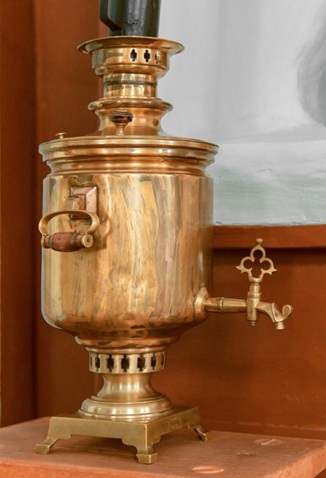
In the 19th century the Russian tea ceremony commonly required the use of a samovar in the household, first only for the upper classes and then spreading to the rest of the people. Sitting around the samovar for a cup of tea was a time to sit and talk and relax.
It was also at this stage that it began being exported to other countries in Central Asia. Samovars were presented in exhibitions and some designs were even awarded medals.
Unfortunately in times of war, many samovars were melted down so that the metal could be used for armory, which in turn were again melted in times of peace to make new samovars.
Today traditional samovars are still produced, but serve mainly as souvenirs or decorative items, whereas the electric samovar is put to use as an electric kettle would be and it is still found in many Russian households.
The Samovar in Other Cultures
In Iran, the samovar has also been present for a few centuries in the tea culture. Adorned with beautiful Persian motifs, these samovars are generally made of silver.
In Kashmir, the samovar was used to make Kashmiri salted tea, a blend of tea, sugar, cardamom and cinnamon. Turkey still uses the samovar today to make its traditional black tea, a concentrated tea that is served in beautiful tea glasses sweetened with lots of sugar.
How to use your samovar
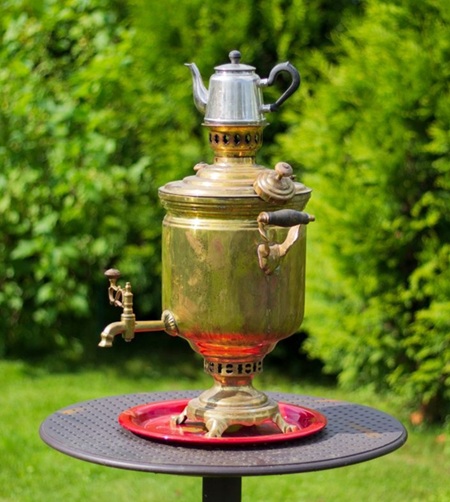
The very first step should be to fill your samovar with water enough for the number of tea cups you are planning to serve. Then turn it on and let the water boil.
The boiling water is also called the Kipyatok in Russian.
Making the tea concentrate (the Zavarka, in Russian)
- Use the boiling water to rinse the teapot.
- Place about 3 tablespoons of black tea leaves in the teapot
- Add boiling water and place it on top of the samovar to keep warm.
- Some will add 2 tablespoons of strawberry jam to sweeten the brew.
- Let the tea concentrate steep for about 15 minutes.
Using the samovar to serve tea
- Once the tea concentrate is ready, pour a bit into a tea cup. About one tenth of the cup to half the cup, this will depend on your own taste.
- Fill the remaining with hot water from the samovar.
- You may add milk to sweeten the tea further.
- If you do not add jam to your tea concentrate, then it is traditional to sweeten the tea with sugar cubes.
It’s easy, isn’t it? Just open the spigot and let the hot water pour into your cup.
Taste your tea the Russian way!
Buy Your Samovar Today!
What teas can be brewed using a samovar?
The samovar is used for concentrated teas and the best quality and most flavorful concentrated teas are made from loose leaf tea black tea. Tea bags will often contain broken leaves and fannings which will result in teas that are bitterer.
Traditionally, Russian tea – a blend of black Chinese and Darjeeling tea – and Turkish tea – a strong black tea are brewed using the samovar.
How to care for your samovar
You should clean your samovar regularly to prevent residue and dirt from building up and ruining the lining. An improperly cleaned samovar will affect the taste of the water you boil inside it and ruin cup after cup of tea.
Cleaning the samovar
A stainless steel samovar is quite easy to clean.
- The teapot may be cleaned by using soap and water. Rinsing well is important so that no soap residue remains.
- Cleaning the inside of the urn should be done with a soft cloth with a small amount of soap and water, taking care not to ruin the electrical parts. Rinse carefully and wipe dry.
- The outside of the urn only required a wipe with a damp cloth to clean it and then with a dry soft cloth to dry it.
- Lime may build inside the samovar, which may be prevented by using bottled water. However, if lime does build up in the interior, fill it with a mixture of water and vinegar overnight. Then empty it and rinse with fresh water so that no vinegar remains and dry with a clean cloth.
The key to a perfect cup of tea every single time is to take care of your samovar.
The Samovar Tea Set
Enjoying a cup of tea is relishing in the traditions of other countries as well as your own. So complete your tea drinking adventure with the following items:
- Russian tea glasses - to honor the Russian tradition, drink your tea from small glasses with decorative metal bases with handles. These can make a collection of very stylish cups.
- Tulip-shaped glasses - in Turkey, tea is drunk from these uniquely shaped glasses sometimes adorned with golden designs. They are placed on small dishes with small teaspoons to stir in the sugar.
- Sugar cubes - add to magic of these tea cultures by sweetening your tea with sugar cubes.
Keep hot water ready for your tea and enjoy a cup at any time of the day.
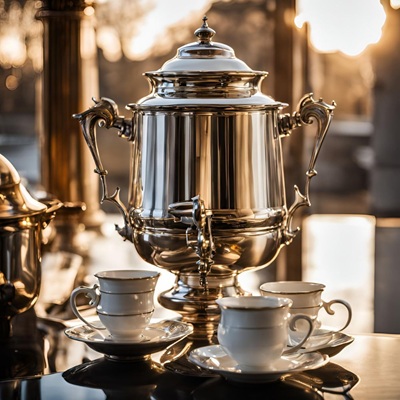
Drinking tea from a samovar
and enjoy the Russian hospitality.
Return from Samovar to Tea Accessories
Return to The Right Tea Homepage

Do you have a question? Then feel free to Contact Us!
And don’t forget to follow us on Facebook to receive updates, photos and interesting tips and news! Follow us also on Pinterest!
Search Website:
Be healthy
with a wide
choice of herbs!

Prepare your tea!
Try these
Tea Samplers!

Wellness Pack at ArtofTea.com

Award Winning Pack ar ArtofTea.com
Find other
tea time items at ...





